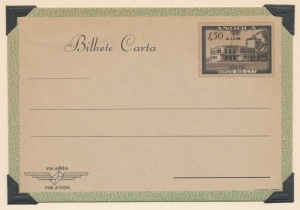One of the pleasures of modern electronic communication is that it costs nothing per word to move. A short sentence costs the same to send as a dense file— that is, zero. And it doesn’t matter how far the recipient is from the sender. An email to next door is the same as one around the world (and due to the way the internet packages bits of information, it is possible that parts of your email to next door may have traveled around the world). This is not true with postal communications. With a letter, real paper needs to be moved, and with intercontinental communications, the cost of moving letters was very high.
Aerograms
Beginning in the 1930s, many countries began to issue aerograms for overseas communication that were sent by Airmail. Aerograms filled a very important purpose. They allowed correspondents to send the one page folded, pre-printed envelopes to each other for a reduced price. There were many stipulations, the most significant being that no enclosures, including another piece of paper, were allowed. Early airmail was restricted by the weight carrying capacity of the early planes. Aerograms were printed on flimsy lightweight paper and would allow many more letters of this type to be carried. The savings from the lighter weight of aerograms was passed onto the postal patron, and aerograms became the favorite of ex-patriots writing to their families back home.
There were problems with the earliest aerograms, and most of the user complaints centered around the thin, lightweight paper. It was felt that the paper was too translucent and gave the writers too little privacy. By 1940, in response to these complaints, most aerograms were printed on security paper with a light burelage that was supposed to obscure the writing inside. Later, aerograms were generally printed on colored stock to make the writing less likely to show through. Postal patrons liked the price of aerograms and used them to the fullest. The Angola aerogram shown above, sent by a missionary woman to her mother, contained over 1,500 words on a 6×9 sheet of paper. It is not unusual to see aerograms with cross writing too, where the writer filled the letter with writing in one direction and then turned the page and wrote across the other way as well.
Aerograms were first issued in the 1930s just after the first airmail stamps began to be issued. They were collected by worldwide stationary collectors, worldwide airmail collectors, and by collectors of the individual countries that issued them. It’s fair to say that they were never enormously popular. Stationary itself has been only a niche interest in our hobby, and aerograms’ status as a niche within a niche never gave it much mainstream acceptance in the hobby. Still, there was a specialized catalog issued for worldwide aerograms by F.W. Kessler in the late 1950s, and about that time, Mr. Kessler was a specialist dealer in these items for a number of years. Later, the lead in aerogram dealing was taken over by A. Lewendowski when Kessler died (Lewendowski later left a considerable bequest to the American Philatelic Society when he died). Over the last thirty years, aerograms have declined in popularity from the low levels they had enjoyed earlier to being a market that barely exists outside of collectors of the stationery for individual countries. Still, if a collector wanted a difficult specialty with thousands of varieties most of which could be had for relatively low cost, the world of aerograms beckons.


